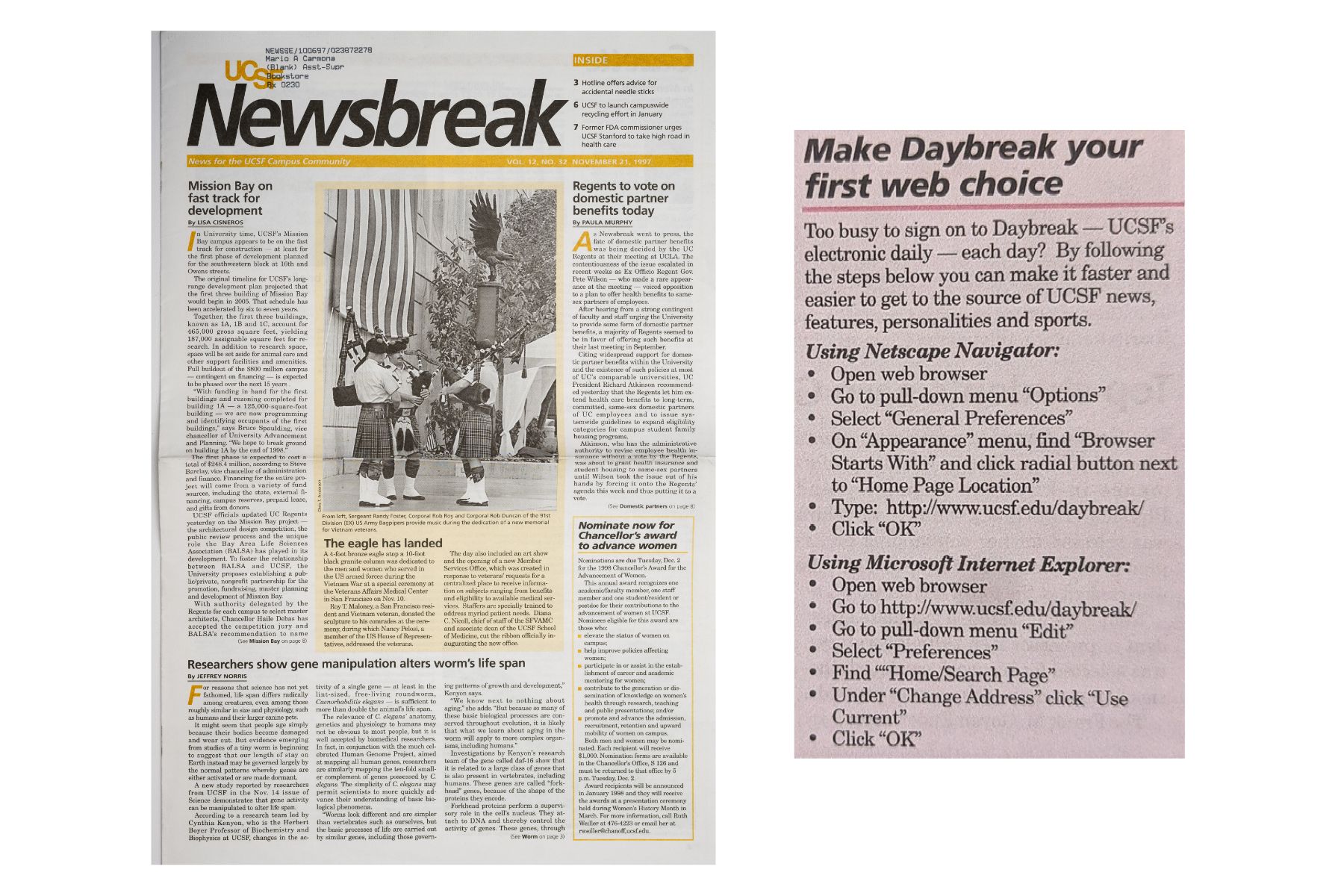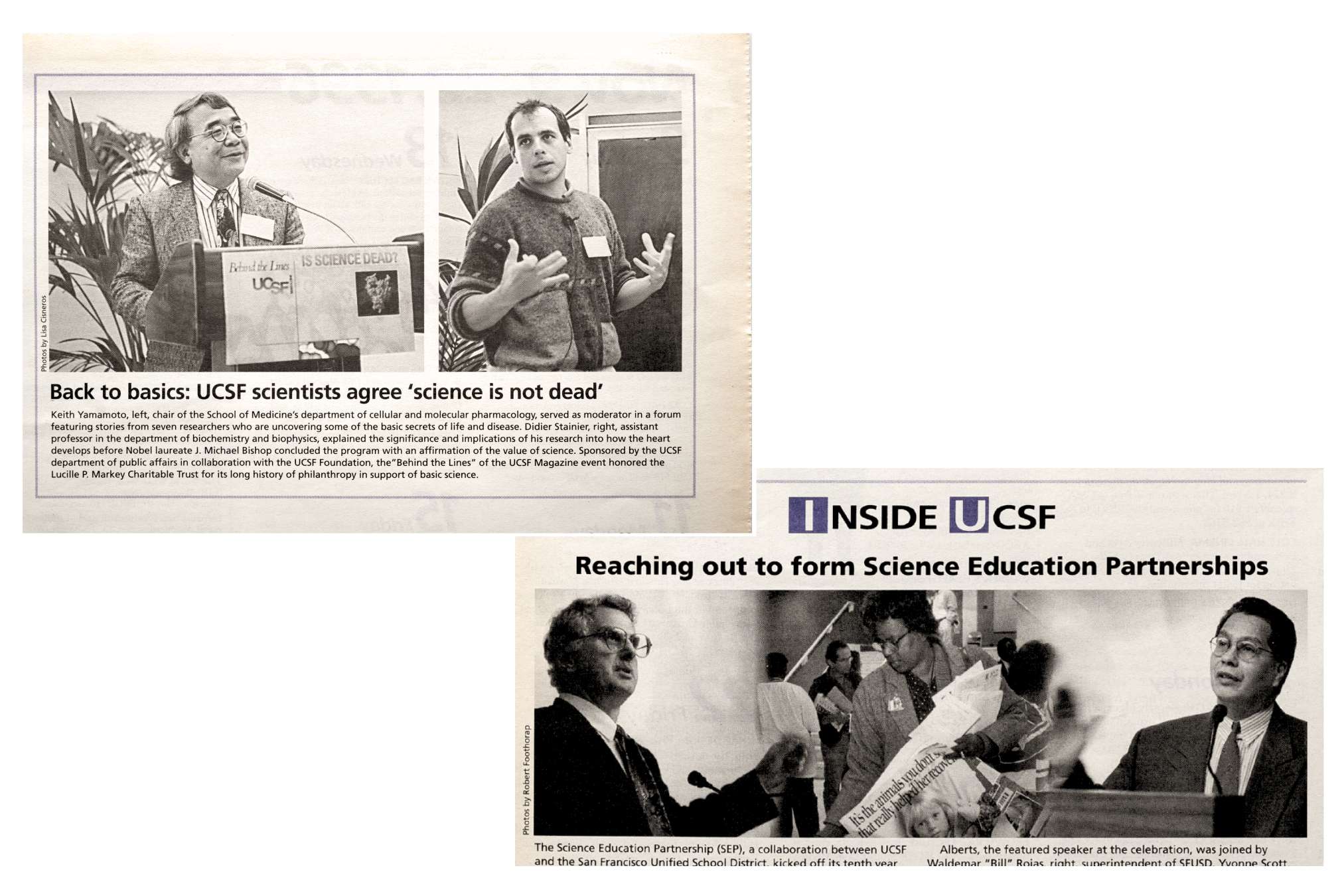With no social media and cable news still in its infancy, major TV networks and daily newspapers were the only game in town.
At UC San Francisco, there was Newsbreak.
The tabloid-sized newspaper was delivered to UCSF employees’ mailboxes – yes, physical mailboxes – once every other week beginning in August 1986 until the publication was ended in the mid-2000s. The paper was oddly split in two – Newsbreak for campus employees and Medsounds for medical center employees. Although the paper was divided, its purpose was the same – informing the UCSF community about the news, events and initiatives happening on campus.

“Before the dawn of online newsletters, the print Newsbreak/Medsounds, and the student paper, Synapse, were our primary sources of information about what was happening at UCSF,” said Brenda Gee, administrative director in the Office of the Executive Vice Chancellor and Provost and member of the UCSF community for 35 years. “They had an important role bringing the community together. When they were delivered, my colleagues and I would take a break to read them together, beginning to end.”
An entire team was behind the newspaper’s production led by the central communications office, then called Public Affairs.
“We would manage printing, do the name addressing and then put them into the mail either through the U.S. Postal Service or actually have them processed through campus mail,” said Mario Carmona, UCSF Documents and Media associate director.


Already at UCSF for three years, Carmona joined what was then known as UCSF Reprographics and Mail in 1997. His team was responsible for the Herculean effort of distributing Newsbreak to roughly 13,000 UCSF employees every two weeks.
“It would be a huge quantity, whatever the run was,” Carmona said. “We would group the papers by box number, then those would have to be distributed to campus mail carriers. They would have to go out to campus and drop off bundles or single copies to get them to employees. If you were in an office of 20 people, you got a stack of 20 and somebody in your office put in your mail slot or left it on your desk. Just imagine that for every issue.”
The whole process would take about three to five days per issue.


Lots of time spent discussing patients.
At that time, the University’s main campuses included Laurel Heights, Mount Zion, Parnassus Heights, San Francisco General Hospital and the Veterans Affairs Medical Center. Mission Bay was still an underdeveloped area in San Francisco when Lisa Cisneros, now executive director of internal communications, joined UCSF Public Affairs in April 1994.
Her byline appeared in many of Newsbreak’s articles over the years, including the birth of the Mission Bay campus.
“When I first came to Mission Bay, I’d be looking at warehouses, abandoned railyards and a golf driving range,” she said of UCSF’s now thriving campus, which today includes UCSF Benioff Children’s Hospital San Francisco,UCSF Betty Irene Moore Women’s Hospital, UCSF Bakar Cancer Hospital and the UCSF Bakar Precision Cancer Medicine Building, plus many outpatient services for children and adults and administrative offices.


“There was not a lot happening here,” Cisneros said.
“The need to find space to expand UCSF’s research and education activities prompted robust discussions about where we were going to develop our second major campus. Once Mission Bay was secured with the donation of 43 acres to UCSF, my job was all about covering how we would make our ambitious vision a reality. It was sort of like, if UCSF builds it, biotech and businesses will come.”
Cisneros started her career at UCSF as a public information officer reporting on campus and medical center news. Others on the Public Affairs staff covered clinical breakthroughs and scientific findings issued as news releases to the media.

“I’d spend my day going to different campuses because the Public Affairs office was based at Laurel Heights, which housed mostly desktop research and administrative offices. For the most part, only symposiums were held there and the University of California Board of Regents met there. When the regents were in town and met at Laurel Heights, it was exciting.”
As the rise of the internet changed the way UCSF Public Affairs published stories about the University, the eight-page paper evolved – taking on a magazine-style feel before ultimately moving to an online publication called Daybreak.
To help people through the transition from a print to digital publication, breakout boxes on the front page of Newsbreak outlined a step-by-step guide on how to get daily news from UCSF.edu.


Eventually, most content went completely online and the print edition was shelved shortly after the Mission Bay campus officially opened. Now much of the newspaper’s contents like internally focused news, announcements and events appear in Campus News, and are promoted in the Pulse newsletter – also produced for the UCSF community every two weeks.
Cisneros – who became editor of Newsbreak in 1996 – held that position until the paper ended its decades-plus run.
She later transitioned to become editor in chief of UCSF.edu.
“It told the story of where UCSF was at that particular moment in time,” she said. “When we’d have stories like the development of Mission Bay, a new chancellor or a Nobel Prize win, Newsbreak was the primary way that UCSF communicated what was happening to faculty, staff and learners.”


Despite the digital transformation of storytelling through video and social media, some still feel nostalgic about the old school days of publishing on print media.
“I love print, so I wish they were still printing these for everybody,” Carmona said. “It was a different time. I think it was one way the University worked to keep us connected as employees. You had a view into what research was happening and what the medical center was doing. As a campus employee, it was a great way to stay connected.”
For those relishing the feel of print, UCSF Magazine and Synapse are available in select locations.
